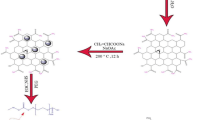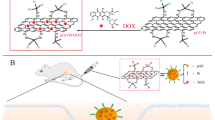Abstract
Purpose
Larger surface area for drug incorporation and superior optical activity makes reduced graphene oxide (rGO) a suitable drug carrier for combination chemotherapeutics delivery. And folate receptors are potential mediators for cancer targeted delivery. This study mainly aimed to prepare irinotecan (IRI)- and docetaxel (DOC)-loaded, folate (FA)-conjugated rGO (FA-P407-rGO/ID) for synergistic cancer therapy.
Methods
FA-P407-rGO/ID was prepared as aqueous dispersion. Characterization was performed using high performance liquid chromatography (HPLC), transmission electron microscopy (TEM), atomic force microscopy (AFM), ultraviolet/visible spectroscopy, fourier transform infrared spectroscopy (FTIR) and drug release. In vitro cellular studies were performed using 3-(4,5-dimethylthiazol-2-yl)-5-(3-carboxymethoxyphenyl)-2-(4-sulfophenyl)-2H-tetrazolium (MTS), fluorescence-activated cell sorting (FACS) and western blot analyses.
Results
Our results revealed successful preparation of stable FA-P407-rGO/ID formulation with enhanced drug release profiles in acidic microenvironment. In vitro cytotoxicity of the formulation on folate receptor-expressing human mammary carcinoma (MCF-7) cells was higher than that when free IRI/DOC combination (ID) was used; such increased cytotoxicity was not observed in folate receptor-negative hepatocellular carcinoma (HepG2) cells. Cellular uptake of FA-P407-rGO/ID in MCF-7 cells was higher than in HepG2 cells. Further, FACS and western blot analysis revealed better apoptotic effects of the formulation in MCF-7 cells than in HepG2 cells, suggesting the important role of folate receptors for targeted chemotherapy delivery to cancer cells. Near infrared irradiation further enhanced the apoptotic effect in cancer cells, resulting from the photothermal effects of rGO.
Conclusions
Hence, FA-P407-rGO/ID can be considered as a potential formulation for folate-targeted chemo-photothermal therapy in cancer cells.









Similar content being viewed by others
Abbreviations
- 1H-NMR:
-
Proton nuclear magnetic resonance
- AFM:
-
Atomic force microscopy
- CDI:
-
1,1ʹ-carbonyldiimidazole
- DOC:
-
Docetaxel
- FA:
-
Folic acid
- FACS:
-
Fluorescence-activated cell sorting
- FITC:
-
Fluorescein-5(6)-isothiocyanate
- FTIR:
-
Fourier transform infrared spectroscopy
- HPLC:
-
High performance liquid chromatography
- ID:
-
Irinotecan and docetaxel combination
- IRI:
-
Irinotecan
- MTS:
-
3-(4,5-dimethylthiazol-2-yl)-5-(3-carboxymethoxyphenyl)-2-(4-sulfophenyl)-2H-tetrazolium
- NIR:
-
Near infrared
- P407:
-
Poloxamer 407
- rGO:
-
Reduced graphene oxide
- TEM:
-
Transmission electron microscopy
References
Zhang Y, Nayak TR, Hong H, Cai W. Graphene: a versatile nanoplatform for biomedical applications. Nanoscale. 2012;4:3833–42.
Yang K, Feng L, Shi X, Liu Z. Nano-graphene in biomedicine: theranostic applications. Chem Soc Rev. 2013;42:530–47.
Feng L, Wu L, Qu X. New horizons for diagnosis and therapeutic applications of graphene and graphene oxide. Adv Mater. 2013;25(2):168–86.
Lu CH, Yang HH, Zhu CL, Chen X, Chen GN. A graphene platform for sensing biomolecules. Angew Chem Int Ed Engl. 2009;48(26):4785–7.
Nayak TR, Andersen H, Makam VS, Khaw C, Bae S, Xu X, et al. Graphene for controlled and accelerated osteogenic differentiation of human mesenchymal stem cells. ACS Nano. 2011;5(6):4670–8.
Sun X, Liu Z, Welsher K, Robinson JT, Goodwin A, Zaric S, et al. Nano-graphene oxide for cellular imaging and drug delivery. Nano Res. 2008;1(3):203–12.
Shim G, Kim JY, Han J, Chung SW, Lee S, Byun Y, et al. Reduced graphene oxide nanosheets coated with an anti-angiogenic anticancer low-molecular-weight heparin derivative for delivery of anticancer drugs. J Control Release. 2014;189:80–9.
Kim H, Lee D, Kim J, Kim TI, Kim WJ. Photothermally triggered cytosolic drug delivery via endosome disruption using a functionalized reduced graphene oxide. ACS Nano. 2013;7(8):6735–46.
Robinson JT, Tabakman SM, Liang Y, Wang H, Casalongue HS, Vinh D, et al. Ultrasmall reduced graphene oxide with high near-infrared absorbance for photothermal therapy. J Am Chem Soc. 2011;133(17):6825–31.
Zhang W, Guo Z, Huang D, Liu Z, Guo X, Zhong H. Synergistic effect of chemo-photothermal therapy using PEGylated graphene oxide. Biomaterials. 2011;32(33):8555–61.
Akhavan O, Ghaderi E, Aghayee S, Fereydooni Y, Talebi A. The use of a glucose-reduced graphene oxide suspension for photothermal cancer therapy. J Mater Chem. 2012;22:13773–81.
Hu SH, Chen YW, Hung WT, Chen IW, Chen SY. Quantum-dot-tagged reduced graphene oxide nano-composites for bright fluorescence bioimaging and photothermal therapy monitored in situ. Adv Mater. 2012;24:1748–54.
Kim MG, Shon Y, Lee J, Byun Y, Choi BS, Kim YB, et al. Double stranded aptamer-anchored reduced graphene oxide as target-specific nano detector. Biomaterials. 2014;35(9):2999–3004.
Miao W, Shim G, Lee S, Choi YS, Oh YK. Safety and tumor tissue accumulation of pegylated graphene oxide nanosheets for co-delivery of anticancer drug and photosensitizer. Biomaterials. 2013;34:3402–10.
Kim YK, Kim MH, Min DH. Biocompatible reduced graphene oxide prepared by using dextran as a multifunctional reducing agent. Chem Commun. 2011;47(11):3195–7.
Stankovich S, Piner RD, Chen XQ, Wu NQ, Nguyen ST, Ruoff RS. Stable aqueous dispersions of graphitic nanoplatelets via the reduction of exfoliated graphite oxide in the presence of poly(sodium 4-styrenesulfonate). J Mater Chem. 2006;16(2):155–8.
Tang LA, Lee WC, Shi H, Wong EY, Sadovoy A, Gorelik S, et al. Highly wrinkled cross-linked graphene oxide membranes for biological and charge-storage applications. Small. 2012;8(3):423–31.
Min K, Han TH, Kim J, Jung J, Jung C, Hong SM, et al. A facile route to fabricate stable reduced graphene oxide dispersions in various media and their transparent conductive thin films. J Colloid Interface Sci. 2012;383(1):36–42.
Thapa RK, Baskaran R, Madheswaran T, Kim JO, Yong CS, Yoo BK. Preparation, characterization, and release study of tacrolimus-loaded liquid crystalline nanoparticles. J Dispers Sci Technol. 2013;34(1):72–7.
Sepehri N, Rouhani H, Tavassolian F, Montazeri H, Khoshayand MR, Ghahremani MH, et al. SN38 polymeric nanoparticles: in vitro cytotoxicity and in vivo antitumor efficacy in xenograft balb/c model with breast cancer versus irinotecan. Int J Pharm. 2014;47(1–2):485–97.
Wang Z, Zeng X, Ma Y, Liu J, Tang X, Gao Y, et al. Antitumor efficiency of D-alpha-tocopheryl polyethylene glycol 1000 succinate-b-poly(epsilon-caprolactone-ran-lactide) nanoparticle-based delivery of docetaxel in mice bearing cervical cancer. J Biomed Nanotechnol. 2014;10(8):1509–19.
Zhao S, Tan S, Guo Y, Huang J, Chu M, Liu H, et al. pH-sensitive docetaxel-loaded D-α-tocopheryl polyethylene glycol succinate-poly(β-amino ester) copolymer nanoparticles for overcoming multidrug resistance. Biomacromolecules. 2013;14(8):2636–46.
Pradhan R, Poudel BK, Ramasamy T, Choi HG, Yong CS, Kim JO. Docetaxel-loaded polylactic acid-co-glycolic acid nanoparticles: formulation, physicochemical characterization and cytotoxicity studies. J Nanosci Nanotechnol. 2013;13(8):5948–56.
Jia J, Zhu F, Ma X, Cao Z, Li Y, Chen YZ. Mechanisms of drug combinations: interaction and network perspectives. Nat Rev Drug Discov. 2009;8(2):111–28.
Badr M, Kopp C, Theison S, Meyer J, Trommer WE. Methotrexate-gelonin conjugate – an inhibitor of MCF-7 cells expressing the dihydrofolate receptor. Biol Chem. 2014;395(12):1461–6.
Zhang C, Gao S, Jiang W, Lin S, Du F, Li Z, et al. Targeted minicircle DNA delivery using folate-poly(ethylene glycol)-polyethylenimine as non-viral carrier. Biomaterials. 2010;31(23):6075–86.
Urbiola K, Garcia L, Zalba C, Garrido MJ. Tros de llarduya C. Efficient serum-resistant lipoplexes targeted to the folate receptor. Eur J Pharm Biopharm. 2013;83(3):358–63.
Hu D, Sheng Z, Fang S, Wang Y, Gao D, Zhang P, et al. Folate receptor-targeting gold nanoclusters as fluorescence enzyme mimetic nanoprobes for tumor molecular colocalization diagnosis. Theranostics. 2014;4(2):142–53.
Thapa RK, Youn YS, Jeong JH, Choi HG, Yong CS, Kim JO. Graphene oxidewrapped PEGylated liquid crystalline nanoparticles for effective chemo-photothermal therapy of metastatic prostate cancer cells. Colloids Surf B Biointerfaces. 2016;143:271–7.
Li D, Muller MB, Gilje S, Kaner RB, Wallace GG. Processable aqueous dispersions of graphene nanosheets. Nat Nanotechnol. 2008;3:101–5.
Lin JJ, Chen JS, Huang SJ, Ko JH, Wang YM, Chen TL, et al. Folic acid-Pluronic F127 magnetic nanoparticle clusters for combined targeting, diagnosis, and therapy applications. Biomaterials. 2009;30(28):5114–24.
Chou TC, Talalay P. Quantitative analysis of dose-effect relationships: the combined effects of multiple drugs or enzyme inhibitors. Adv Enzym Regul. 1984;22:27–55.
Basiruddin SK, Swain SK. Phenylboronic acid functionalized reduced graphene oxide based fluorescence nano sensor for glucose sensing. Mater Sci Eng C Mater Biol Appl. 2016;58:103–9.
Eda G, Chhowalla M. Chemically derived graphene oxide: towards large area thin film electronics and optoelectronics. Adv Mater. 2010;22(22):2392–415.
Wang Y, Liu K, Luo Z, Duan Y. Preparation and tumor cell model based biobehavioral evaluation of the nanocarrier system using partially reduced graphene oxide functionalized by surfactant. Int J Nanomed. 2015;10:4605–20.
Chen D, Li L, Guo L. An environment-friendly preparation of reduced graphene oxide nanosheets via amino acid. Nanotechnology. 2011;22(32):325601.
Swain AK, Bahadur D. Enhanced stability of reduced graphene oxide colloid using cross-linking polymers. J Phys Chem C. 2014;118(18):9450–7.
Ren J, Fang Z, Yao L, Dahmani FZ, Yin L, Zhou J, et al. A micelle-like structure of poloxamer-methotrexate conjugates as nanocarrier for methotrexate delivery. Int J Pharm. 2015;487(1–2):177–86.
Bontha S, Kabanov AV, Bronich TK. Polymer micelles with cross-linked ionic cores for delivery of anticancer drugs. J Control Release. 2006;114(2):163–74.
Wang H, Gu W, Xiao N, Ye L, Xu Q. Chlorotoxin-conjugated graphene oxide for targeted delivery of an anticancer drug. Int J Nanomed. 2014;9:1433–42.
Zhang Z, Yao J. Preparation of irinotecan-loaded folate-targeted liposome for targeting delivery and its antitumor activity. AAPS PharmSciTech. 2012;13(3):802–10.
Xu P, Meng Q, Sun H, Yin Q, Yu H, Zhang Z, et al. Shrapnel nanoparticles loading docetaxek inhibit metastasis and growth of breast cancer. Biomaterials. 2015;64:10–20.
Tang Y, Czuczman PR, Chung ST, Lewis AL. Preservation of the active lactone form of irinotecan using drug eluting beads for the treatment of colorectal cancer metastases. J Control Release. 2008;127(1):70–8.
Niu J, Wang A, Ke Z, Zheng Z. Glucose transporter and folic acid receptor-mediated Pluronic P105 polmeric micelles loaded with doxorubicin for brain tumor treating. J Drug Target. 2014;22(8):712–23.
Tang W, Su G, Li J, Liao J, Chen S, Huang C, et al. Enhanced anti-colorectal cancer effects of carfilzomib combined with CPT-11 via downregulation of nuclear factor-kB in vitro and in vivo. Int J Oncol. 2014;45(3):995–1010.
Edvardsen H, Brunsvig PF, Solvang H, Tsalenko A, Andersen A, Syvanen AC, et al. SNPs in genes coding for ROS metabolism and signaling in association with docetaxel clearance. Pharmacogenomics J. 2010;10(6):513–23.
ACKNOWLEDGMENTS AND DISCLOSURES
This research was supported by the National Research Foundation of Korea (NRF) grant funded by the Korea government (MSIP) (No. 2015R1A2A2A01004118, 2015R1A2A2A04004806). This work was also supported by the Medical Research Center Program (2015R1A5A2009124) through the NRF funded by MSIP.
Author information
Authors and Affiliations
Corresponding authors
Electronic supplementary material
Characterizations of FA-P407 conjugate and FA-P407-rGO/ID; cytotoxicity and cellular uptake analysis.
ESM 1
(DOCX 2851 kb)
Rights and permissions
About this article
Cite this article
Thapa, R.K., Choi, Y., Jeong, JH. et al. Folate-Mediated Targeted Delivery of Combination Chemotherapeutics Loaded Reduced Graphene Oxide for Synergistic Chemo-Photothermal Therapy of Cancers. Pharm Res 33, 2815–2827 (2016). https://doi.org/10.1007/s11095-016-2007-0
Received:
Accepted:
Published:
Issue Date:
DOI: https://doi.org/10.1007/s11095-016-2007-0




